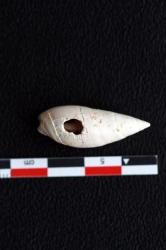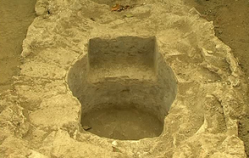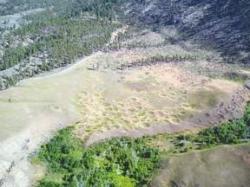INSTITUT SUPERIEUR D'ANTHROPOLOGIE
INSTITUTE OF ANTHROPOLOGY
ONLINE COURSES / COURS A DISTANCE
INSCRIPTION : Année Universitaire 2012/2013
REGISTRATION : Academic Year 2012 / 2013
FRANCE -  Chézy-sur-Marne - Dans leur sol, ont été découvertes des preuves de présence humaine, il y a 17 000 ou 18 000 ans. Jusque-là, les scientifiques pensaient cette zone inhabitée à ce moment-là. Tout simplement parce qu'il faisait trop froid ! « C'est la fin de la dernière glaciation », indique Cyril Montoya, ingénieur de recherche à la Direction régionale des affaires culturelles (DRAC) Picardie. « C'est la plus ancienne trace d'occupation bien datée, pour cette période, dans tout le Nord de la France », révèle Cyril Montoya. Si l'enthousiasme ne perce pas trop dans sa voix, son interlocuteur reste bouche bée. Et veut en savoir plus sur ces hommes ayant vécu en 15 000 ou 16 000 avant Jésus Christ. Ils se paraient de bijoux, les coquillages percés retrouvés sur place en témoignent, et ils chassaient le renne. Des os ont été découverts d'une manière montrant qu'ils ont été rapportés au campement de ces groupes, donc de chasseurs-cueilleurs vivant pendant le paléolithique supérieur. Des os de chevaux étaient également sur les lieux. La vallée de la Marne, à proximité, faisait apparemment office de couloir de migration pour les hardes de ces deux espèces. Et, là où était le gibier, étaient nos nomades de prédécesseurs. Ces derniers vivaient en plein air et non dans des grottes, détail qui rend encore plus exceptionnel l'état de conservation des traces de leur passage. Il est dû, explique Cyril Montoya, au lœss situé dans cette région « un sédiment apporté par le vent pendant les périodes glacières, une sorte de sable ». La constitution du sol -et notamment le calcaire, parfois maudit, auront été utiles… Non seulement les vestiges se sont bien conservés mais les ressources minérales - avec « les coteaux riches en silex » dans cet ancien fonds marin ayant déposé nombre de coquillages- ont joué un rôle non négligeable d'attraction pour les hommes… Les restes d'un foyer en disent encore un peu plus sur leur manière de vivre car tous les détails sont examinés scrupuleusement et de nombreux experts, représentant de multiples spécialités, sont amenés à intervenir au cours des prochains mois pour tirer le maximum d'information de ces témoignages préhistoriques.
Chézy-sur-Marne - Dans leur sol, ont été découvertes des preuves de présence humaine, il y a 17 000 ou 18 000 ans. Jusque-là, les scientifiques pensaient cette zone inhabitée à ce moment-là. Tout simplement parce qu'il faisait trop froid ! « C'est la fin de la dernière glaciation », indique Cyril Montoya, ingénieur de recherche à la Direction régionale des affaires culturelles (DRAC) Picardie. « C'est la plus ancienne trace d'occupation bien datée, pour cette période, dans tout le Nord de la France », révèle Cyril Montoya. Si l'enthousiasme ne perce pas trop dans sa voix, son interlocuteur reste bouche bée. Et veut en savoir plus sur ces hommes ayant vécu en 15 000 ou 16 000 avant Jésus Christ. Ils se paraient de bijoux, les coquillages percés retrouvés sur place en témoignent, et ils chassaient le renne. Des os ont été découverts d'une manière montrant qu'ils ont été rapportés au campement de ces groupes, donc de chasseurs-cueilleurs vivant pendant le paléolithique supérieur. Des os de chevaux étaient également sur les lieux. La vallée de la Marne, à proximité, faisait apparemment office de couloir de migration pour les hardes de ces deux espèces. Et, là où était le gibier, étaient nos nomades de prédécesseurs. Ces derniers vivaient en plein air et non dans des grottes, détail qui rend encore plus exceptionnel l'état de conservation des traces de leur passage. Il est dû, explique Cyril Montoya, au lœss situé dans cette région « un sédiment apporté par le vent pendant les périodes glacières, une sorte de sable ». La constitution du sol -et notamment le calcaire, parfois maudit, auront été utiles… Non seulement les vestiges se sont bien conservés mais les ressources minérales - avec « les coteaux riches en silex » dans cet ancien fonds marin ayant déposé nombre de coquillages- ont joué un rôle non négligeable d'attraction pour les hommes… Les restes d'un foyer en disent encore un peu plus sur leur manière de vivre car tous les détails sont examinés scrupuleusement et de nombreux experts, représentant de multiples spécialités, sont amenés à intervenir au cours des prochains mois pour tirer le maximum d'information de ces témoignages préhistoriques.
http://www.lunion.presse.fr/article/aisne/chezy-sur-marne-decouverte-archeologique-sous-nos-pieds-des-traces-humaines-dil-y-a-au
BULGARIE –  Byala - Varna archaeologists working at a site of an ancient fortress near Cape Saint Atanas in Byala on Bulgaria’s Black Sea coast have found early Christian baptismal fonts, estimated to date from the fifth to sixth centuries CE, as well as the foundations of a basilica. Also found near the basilica site were the foundations of accommodation, believed to have been the housing of a local bishop. Other discoveries included a spring believed to have been used as a source for holy water, a winery, bath and a kiln for ceramics. In all, three baptismal fonts were found. One was in the basilica and the other two some metres from it, located one above the other, one from the fifth century and the other from the sixth. The fonts were found while archaeologists were investigating religious sites from the time before Jesus. Two of the fonts are cross-shaped. The report said that scholars believed that in the fifth to sixth centuries, practices in Christianity varied and changes in rituals explain the presence of the third font. Archaeologists said that the discoveries change perceptions of early Christian architecture not only in Bulgaria but in the entire Byzantine world.
Byala - Varna archaeologists working at a site of an ancient fortress near Cape Saint Atanas in Byala on Bulgaria’s Black Sea coast have found early Christian baptismal fonts, estimated to date from the fifth to sixth centuries CE, as well as the foundations of a basilica. Also found near the basilica site were the foundations of accommodation, believed to have been the housing of a local bishop. Other discoveries included a spring believed to have been used as a source for holy water, a winery, bath and a kiln for ceramics. In all, three baptismal fonts were found. One was in the basilica and the other two some metres from it, located one above the other, one from the fifth century and the other from the sixth. The fonts were found while archaeologists were investigating religious sites from the time before Jesus. Two of the fonts are cross-shaped. The report said that scholars believed that in the fifth to sixth centuries, practices in Christianity varied and changes in rituals explain the presence of the third font. Archaeologists said that the discoveries change perceptions of early Christian architecture not only in Bulgaria but in the entire Byzantine world.
http://sofiaglobe.com/2012/09/27/archaeology-early-christian-baptismal-fonts-found-at-ancient-fortress-site-in-bulgarias-byala/
INDE –  Alamparai - Hitherto undiscovered remnants from the historic port town of Alamparai are now in public view. The unearthed artefacts are on display at the Tamil Nadu Department of Archaeology. R. Vasanthi, commissioner in-charge, state department of archaeology, said though it was a limited excavation, the focus was on confirming the existence of a mint which, in early literature, was referred to as ‘akkasalai’ or a state mint.“We also wanted to trace the trade relations and socio-economic scenario of the period. The most crucial findings were the coin moulds and crucibles dated between 17 C.E. and 18 C.E., though we were not able to find any coins itself,” she said, adding that porcelain, canon balls, necked bottles of the British period, smoking pipes and amulets, all belonging to the 17 C.E. and 18 C.E. were found. S. Gurumurthy, retired professor, ancient history and archaeology, Madras University, who was present at the exhibition, said the excavations establish the town’s position as both a port and a fort town. “The porcelain items which have been found came from outside the country, and establish its position as a trading town. The dailies of the 17 C.E. and 18 C.E. make several mentions of political contact between the rulers of Alamparai and Pondicherry and it is also reffered to as ‘Alampuravi’ in archival records,” he said, adding that the iron nails and pieces reflect their knowledge of metallurgy. While the excavation was carried out within the premises of the fort, starting January, areas such as Alamparai Village, Vembanur, Idaikkalinadu and Nallur were surveyed in December. “The presence of crucibles, coin moulds and slags, are indicative of the activity of coin-making and the smelting of metals and glass for manufacturing of utensils,” said Ms. Vasanthi. The excavation was carried out by a team of 15 experts and was lead by V. Ramamurthy, excavation archaeologist. Over 200 antiquities were excavated, she said, adding that the documentation process was underway. “The report would be completed within two months,” she said.
Alamparai - Hitherto undiscovered remnants from the historic port town of Alamparai are now in public view. The unearthed artefacts are on display at the Tamil Nadu Department of Archaeology. R. Vasanthi, commissioner in-charge, state department of archaeology, said though it was a limited excavation, the focus was on confirming the existence of a mint which, in early literature, was referred to as ‘akkasalai’ or a state mint.“We also wanted to trace the trade relations and socio-economic scenario of the period. The most crucial findings were the coin moulds and crucibles dated between 17 C.E. and 18 C.E., though we were not able to find any coins itself,” she said, adding that porcelain, canon balls, necked bottles of the British period, smoking pipes and amulets, all belonging to the 17 C.E. and 18 C.E. were found. S. Gurumurthy, retired professor, ancient history and archaeology, Madras University, who was present at the exhibition, said the excavations establish the town’s position as both a port and a fort town. “The porcelain items which have been found came from outside the country, and establish its position as a trading town. The dailies of the 17 C.E. and 18 C.E. make several mentions of political contact between the rulers of Alamparai and Pondicherry and it is also reffered to as ‘Alampuravi’ in archival records,” he said, adding that the iron nails and pieces reflect their knowledge of metallurgy. While the excavation was carried out within the premises of the fort, starting January, areas such as Alamparai Village, Vembanur, Idaikkalinadu and Nallur were surveyed in December. “The presence of crucibles, coin moulds and slags, are indicative of the activity of coin-making and the smelting of metals and glass for manufacturing of utensils,” said Ms. Vasanthi. The excavation was carried out by a team of 15 experts and was lead by V. Ramamurthy, excavation archaeologist. Over 200 antiquities were excavated, she said, adding that the documentation process was underway. “The report would be completed within two months,” she said.
http://www.thehindu.com/arts/history-and-culture/tracing-the-origins-of-the-regions-earliest-mint/article3939437.ece
INDE – Sivasagar - Archaeologists have found a training ground for guerilla fighters from the Tai Ahom era in east Assam — perhaps the only such historical site in India. The site (of which 27 bighas remain) found near Sivasagar — once the seat of the Ahom royals 400 km east of Guwahati — would have resembled the Indian Army-run counter insurgency and jungle warfare training school, which is located at Vairangte in Mizoram. “The site comprises a series of small earthen mounds that were probably used for guerilla training or to stage a mock war," said HN Dutta, director, Directorate of Assam Archaeology, who led the effort. Dutta refrained from assigning an exact date to the site's construction saying more work, including excavation, was required to get such details. The Ahoms, a warrior race of Tai lineage, originated from the Yunnan plateau in southwest China, first made their appearance in northeastern Assam in the 13th century and ruled Assam till 1826. Known to have ruled Assam for about 600 years, they halted several bids by the Mughals to capture the east. In these battles, the Ahoms carved out a legendary name for their guerilla warfare prowess — locally called 'daga judho' — a dependable tactic where smaller numbers face a numerically larger army. These fighters practiced 'Lai Lung Tham', a form of martial art widely used before it fell into disuse."Though the Ahoms did not have a huge standing army, there were groups of expert warriors who also operated as the kings' bodyguards. In all probability, these warriors practiced their skills on the site," said Prof Sangeeta Gogoi, a leading authority on Ahoms.
http://www.hindustantimes.com/India-news/NewDelhi/Found-Medieval-training-site-for-Ahom-warriors/Article1-936211.aspx
CANADA –  Keatley Creek - Archeologists continue to work with Lillooet First Nations to excavate and study an extensive village of pit houses and food caches dating back approximately 2,000 years. Keatley Creek, a four-hectare site, located in the Fraser Canyon between Xaxli’p and Ts’kw’aylaxw, the modern-day First Nations communities at Fountain and Pavilion, is home to more than 115 pre-historic pit houses called Quigglies and the artifacts of those who occupied them in large family groups. A reconstruction of such an underground house can be seen by the public near the Lillooet Tribal Council’s offices near the community of T'it'q'et. These have been the subject of formal archaeological investigation and evidence indicates its origins to have been between 4,800 BC and 2,400 BC, with ongoing habitation for thousands of years, up to 1,100 BC. There would have been a timber and earth structure above, though the pits are all that remain. Beneath each pit and its surrounding rim is a treasure trove of discarded material and artifacts that has lain buried for thousands of years.
Keatley Creek - Archeologists continue to work with Lillooet First Nations to excavate and study an extensive village of pit houses and food caches dating back approximately 2,000 years. Keatley Creek, a four-hectare site, located in the Fraser Canyon between Xaxli’p and Ts’kw’aylaxw, the modern-day First Nations communities at Fountain and Pavilion, is home to more than 115 pre-historic pit houses called Quigglies and the artifacts of those who occupied them in large family groups. A reconstruction of such an underground house can be seen by the public near the Lillooet Tribal Council’s offices near the community of T'it'q'et. These have been the subject of formal archaeological investigation and evidence indicates its origins to have been between 4,800 BC and 2,400 BC, with ongoing habitation for thousands of years, up to 1,100 BC. There would have been a timber and earth structure above, though the pits are all that remain. Beneath each pit and its surrounding rim is a treasure trove of discarded material and artifacts that has lain buried for thousands of years.
http://www.lillooetnews.net/article/20120926/LILLOOET0604/309269995/-1/lillooet/reconstructing-a-picture-of-prehistory
FRANCE – Rennes - Difficile d'imaginer que Rennes fut une ville fortifiée plusieurs siècles durant. Les Portes Mordelaises, cachées en bas de la place des Lices, en attestent pourtant. Actuellement sous la main des archéologues de l'Inrap (Institut national de recherches archéologiques préventives), elles sont le dernier vestige des remparts. Mais où sont donc les autres traces du passé médiéval de la ville ? « Au XVIIe siècle, les villes avaient besoin de foncier et ont remblayé les fossés. Les remparts étaient souvent démantelées ou vendues à des particuliers », explique Elen Esnault, chercheuse à l'Inrap. Mais si les portes mordelaises ont été conservées au fil des siècles, ce n'est pas pour leur beauté : elles abritaient le logis du gouverneur et du capitaine au XVIIe siècle et n'ont pas été détruites. Et ce, malgré la demande du roi Henri IV. A l'époque, les portes offraient l'un des rares accès à la ville. Aujourd'hui noyées dans le centre ancien et enclavées par des bâtiments de toutes les époques, elles seront valorisées, promet la municipalité.
http://www.20minutes.fr/article/1011277/portes-dernier-rempart-passe